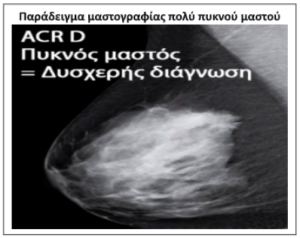27 Jun Dense Breast: What Dangers Does It Hold?
A dense breast is considered a breast that has more mammary gland than fatty tissue. A dense breast makes mammograms more difficult to interpret and increases the risk of developing cancer up to six times. It is a condition that affects about 50% of women aged 40 and over. Although few women know this, breast density is an important risk factor for developing cancer. It has been observed that the higher the percentage of density, the more likely it is to develop breast cancer. International studies are conducted by the Division of Cancer Epidemiology and Genetics (DCEG) of the US National Cancer Institute, which has developed an interdisciplinary research program.
How Can I Know If I Have Dense Breasts?
Breast density is a measure of the ratio between glandular, connective and fatty tissue within the breast. It is impossible to determine breast density by clinical examination or self-examination. The only way to show if a woman has dense breasts is a mammogram. For this reason, the correct definition given is that of “dense breast on mammography”.
How Common Is It to Have Dense Breasts?
Dense breast is not an abnormal or pathological condition, but it is very common in women. About 50% of women age 40 and older who have mammograms have dense breasts. This trait is often inherited, but there are other factors that can affect it. Factors associated with lower density are:
- age (the older the woman, the more the amount of glandular tissue decreases)
- women who have children
- for women who have had breast cancer, treatment with tamoxifen.
A higher density is associated with hormone replacement therapy intake at menopause and in cases with a low body mass index.
Does Having Dense Breasts Affect Mammography?
Dense breast tissue appears white and opaque on a mammogram, just like dangerous abnormalities eg. calcifications and tumors. This is why a mammogram is more difficult to interpret and can be more difficult to detect a cancer. As a result, women with dense breasts should have diagnostic tests more often than women with fatty breasts.
How Is Breast Density Classified?
The US classification (ACR) is used, which divides women into 4 categories. The first is for those with an amount of opaque glandular tissue on mammography between 0% and 25% (almost completely fat), the second between 25% and 50%, the third between 50% and 75% (“heterogeneous dense”, it concerns about 40% of women) and the fourth over 75% (“extremely dense”, affects about 10% of women).
The third and fourth categories are those for whom the risk of breast cancer increases significantly. In the highest category, in fact, one in three breast cancers can be underestimated, so it is necessary to do an ultrasound and in some cases an MRI is also indicated.

Can Having Dense Breasts Affect Breast Cancer Mortality?
Studies show that density is not a factor affecting survival chances. This means that the risk of death of those who have dense breasts and become ill is no different from patients with fatter breasts.
Should Women With Dense Breasts Get Their Mammograms More Often Than Others?
Women with dense breasts should see a specialist mammologist to draw up an individualized prevention program with imaging tests and palpation.
What to Ask the Mammologist After Having a Mammogram
Here are a series of questions:
- What did my last mammogram show? Are there areas of dense tissue that are at particular risk?
- Are there other tests recommended for me? Can 3D mammography (tomography), MRI or ultrasound help get a clearer picture?
- What are the risk factors and protective factors?
- What can I do to reduce my risk of breast cancer?
